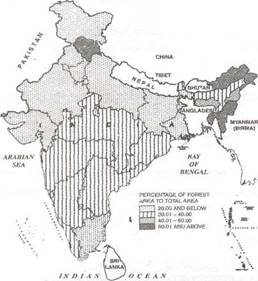Q.1. Name two island groups of India . Mention one feature of each island group. 1+1=2
Q. 2* Mention two contributions of Ishwar Chandra Vidyasagar. 2
Q. 3. Define the term 'Human-made (cultural) Resources'. Give two examples of these resources. 1+1=2
Q. 4. What is a multipurpose project? Mention any two purposes served by a multipurpose project. 1+1=2
Q. 5. State any four salient features of 'National Highways'. 4x1/2=2
Q. 6. Why is it necessary to conserve our natural resources? Give two reasons. 2x1=2
Q. 7. Explain any two human activities responsible for land degradation. 2x1=2
Q. 8. Study the map given below, showing distribution of forests in India and answer the questions that follow: 1+1=2

(8.1) Name any too States from north-east India having more than 60 per cent of their area under forest cover.
(8.2) Why have these States larger forest area? Give two reasons.
Note: The following question is for Blind Candidates only in lieu of Q. No. 8.
Explain two reasons for having high percentage of forest cover in North-Eastern States of India.
Q. 9. State any two problems that forced India after 1991 to undertake New Economic Policy. 2
Q. 10. State too beneficial and too harmful effects of W.T.O. (World Trade Organization) on Indian economy. 1/2x4=2
Q. 11. Mention too features of capitalist economy. 1+1=2
Q. 12. "Problem of resource allocation in mixed economy is effectively solved through market forces and planning process." Give too facts to support this statement. 2
Q. 13. "A moderate and gradual rise in price for all the goods is considered good for any country". Do you agree with this view? Give too arguments to support your answer. 2
Q. 14.* Describe the impact of British rule on 19th century Indian Society. 4
Q. 15.* What were the main causes of the failure of the Revolt of 1857? 4
Or
What is Stupa? Explain the historical importance of Sanchi Stupa. 4
Q. 16. Explain the importance of 'Radio' and 'Television' as effective means of mass communication in our country. 2+2=4
Q. 17. Explain three strategies adopted by the Government to protect the interest of consumers with reference to Consumer Protection Act of 1986. 4
Q. 18. What is meant by cross border terrorism? Give its main characteristics. 4
Q. 19. How does growth rate in population increase poverty in a country? Explain. 4
Q. 20.* Briefly describe social evils of Indian society during the nineteenth century. 6
Q. 21. What is 'Energy Conservation Act'? Describe five measures for efficient use of energy. 1+5=6
Q. 22. What is globalisation? Explain its impact on Indian agriculture by mentioning five points. 1+5=6
Or
Explain any six steps taken by the 'Central' and 'State' Governments to improve Indian agriculture after independence. 6x1=6
Q. 23. Explain why cotton textile industry is largely concentrated in Gujarat and Maharashtra ? Examine the problems being faced by this industry. 3+3=6
Q. 24. Examine the causes for the rise in prices in India . Give six reasons. 6
Or
Examine the causes of poverty and explain any three measures adopted to remove poverty in India .
Q. 25. What is meant by social development? Explain its importance for the progress of India . 6
Or
What is meant by human development? Explain how human development is the essence of social development.
Q. 26. Define communalism. Explain the causes for the rise of communalism in India . 6
Q. 27. (a)* On the given map of India , locate and label any two of the following centres of Revolt of 1857:
(i) Jhansi (ii) Gwalior (Hi) Lucknow 2
Note: The following question is for the Blind Candidates only in lieu of Q. No. 27(a):
(a) Why was the Non-Cooperation Movement called off by Gandhiii? 2
(b) In the given outline political map of India [27 (b) & (c)] are shown three geographical features. Identify these features marked as A, B, C. Write their names correctly on the space provided in the map. Attach the map in your answer-book. 1 *3=3
(c) In the same given outline political map of India locate and label the following features and attach the map in your answer-book: 3*1=3
(i) Koyali Oil Refinery,
(ii) Salem Iron and Steel Plant,
(iii) Vishakhapatnam Port.